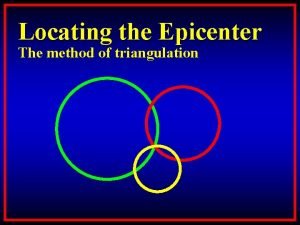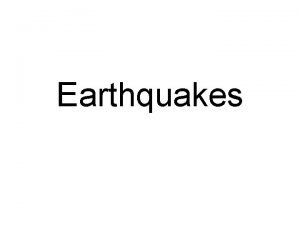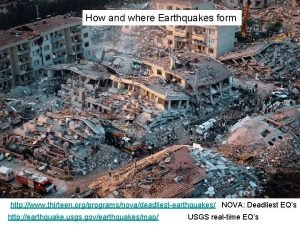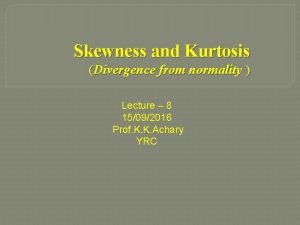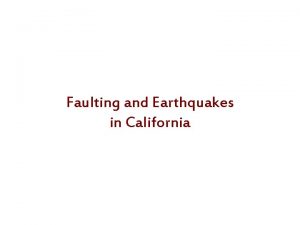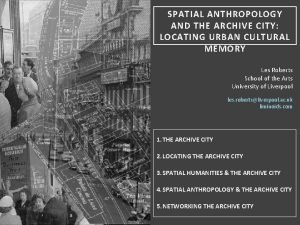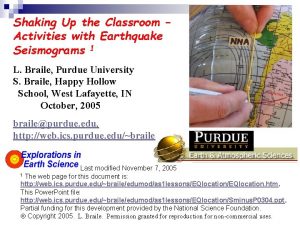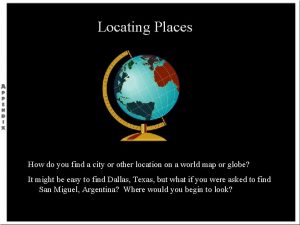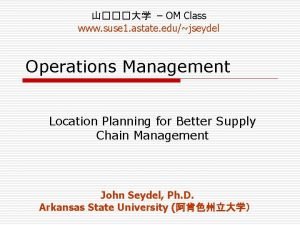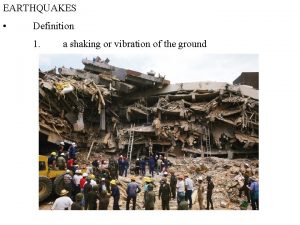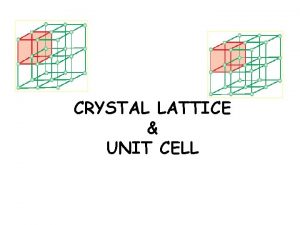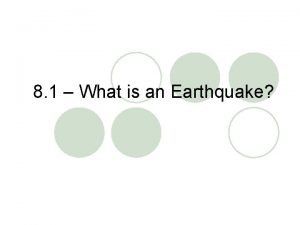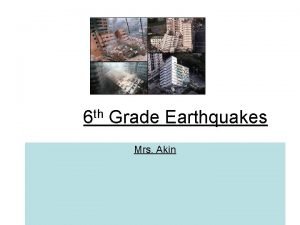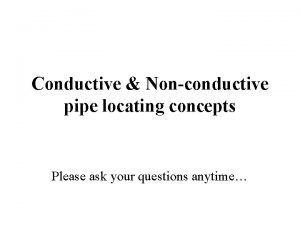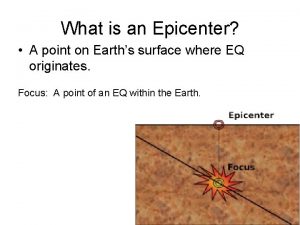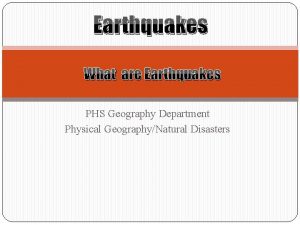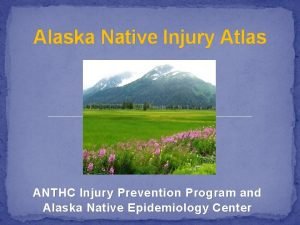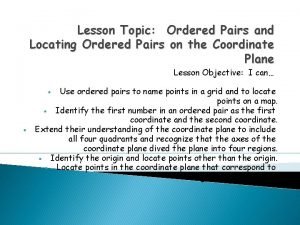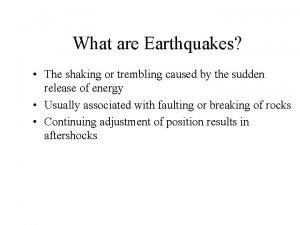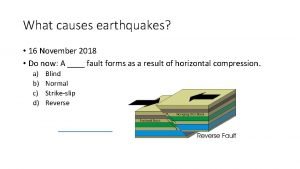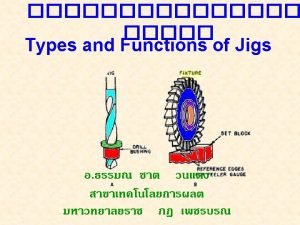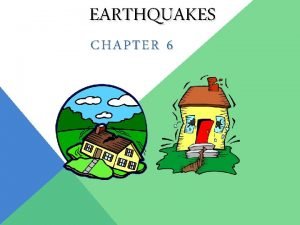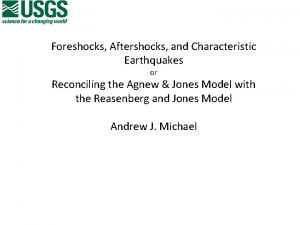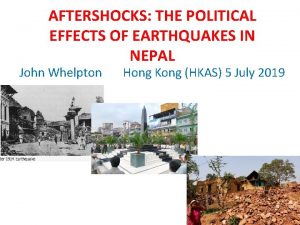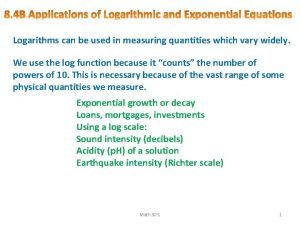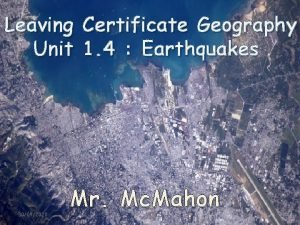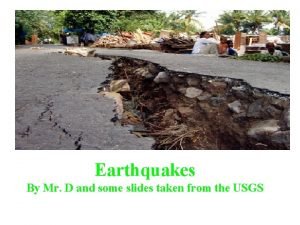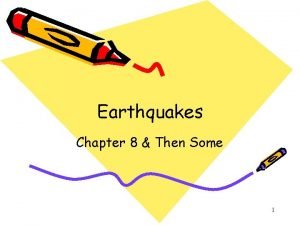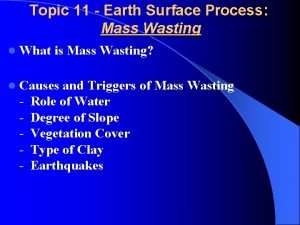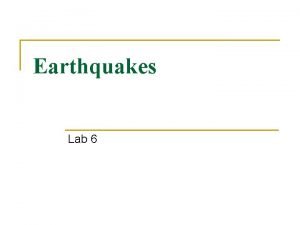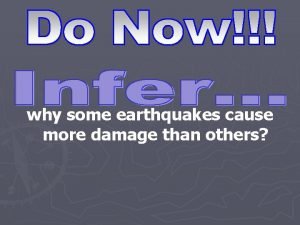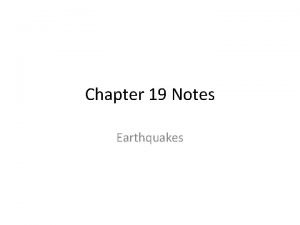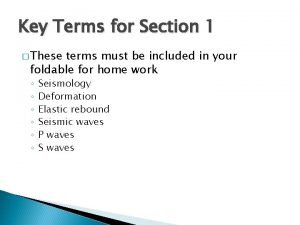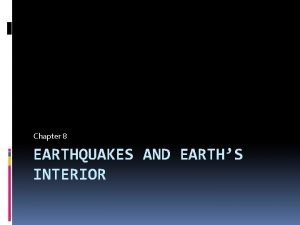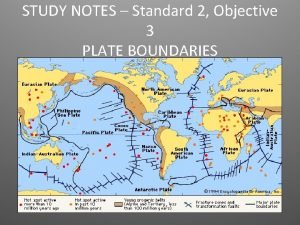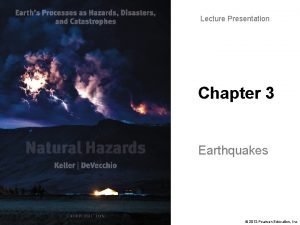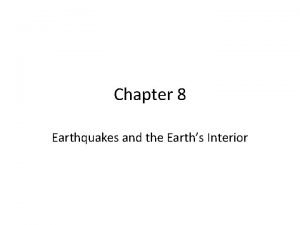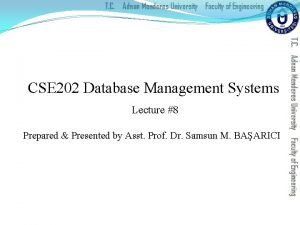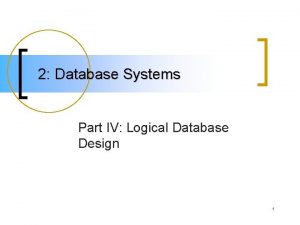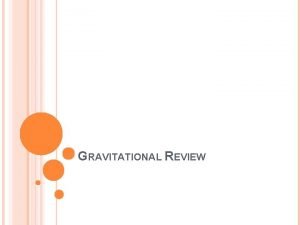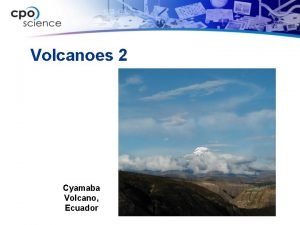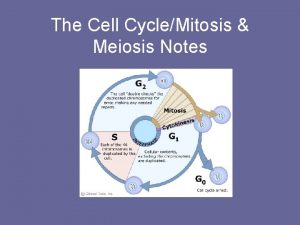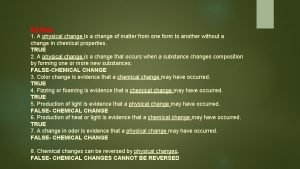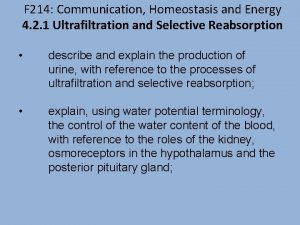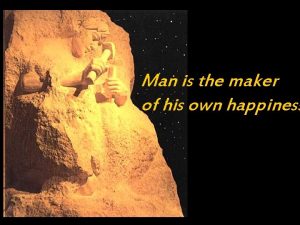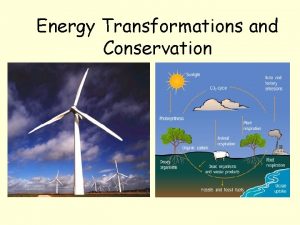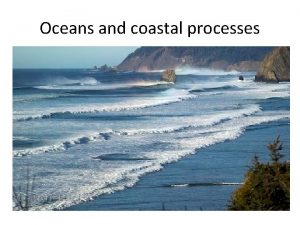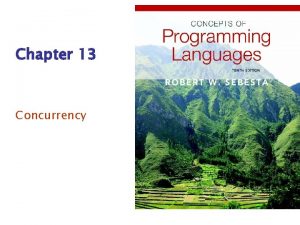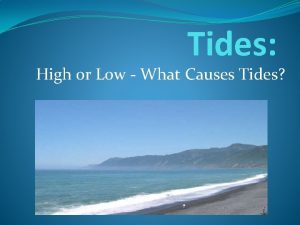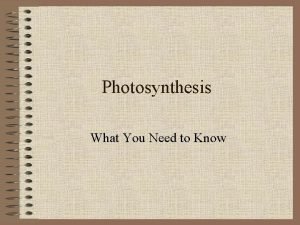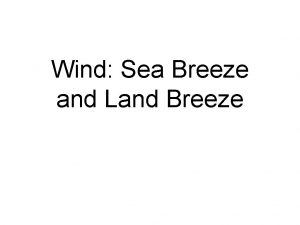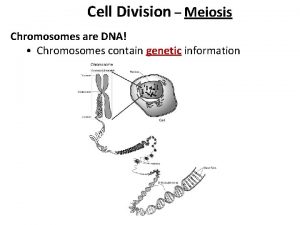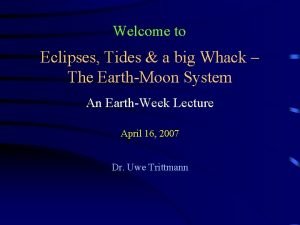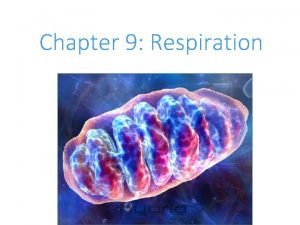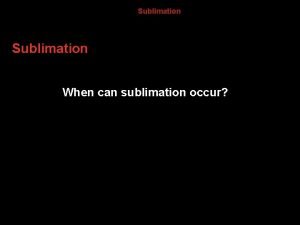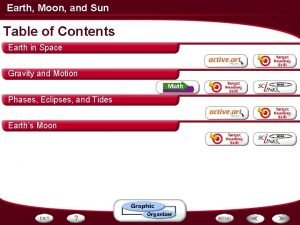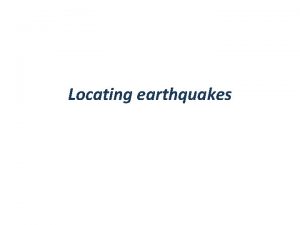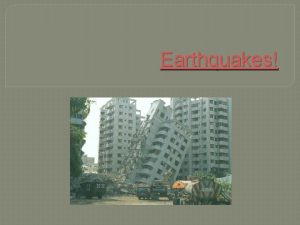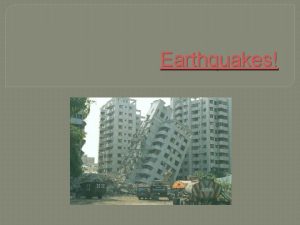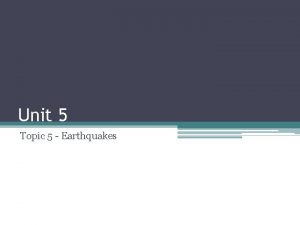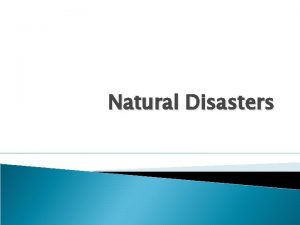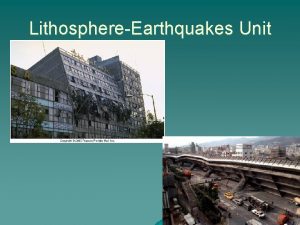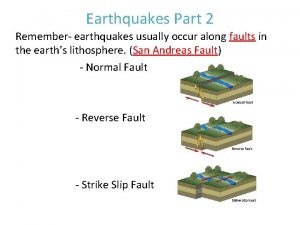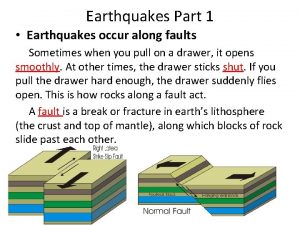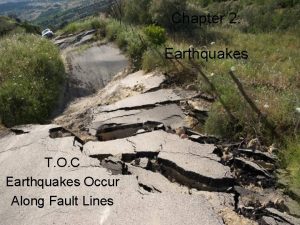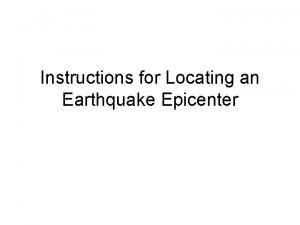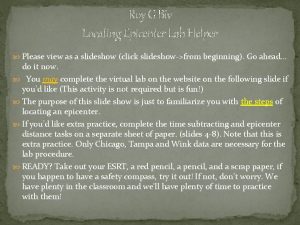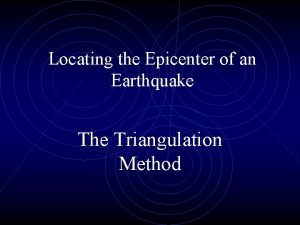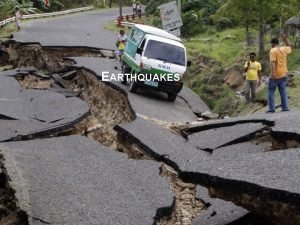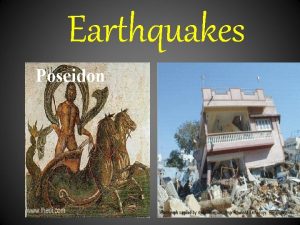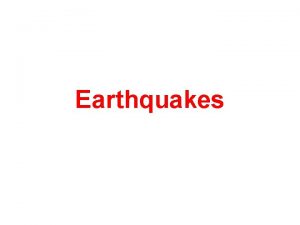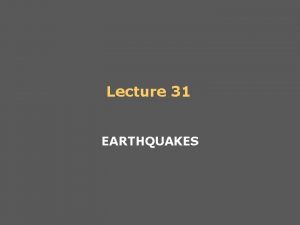LOCATING AN EPICENTER X Earthquakes occur in many



































































































- Slides: 99

LOCATING AN EPICENTER X

Earthquakes occur in many distance places, and many of them occur under oceans. However, a seismologist with suitable equipment does not have to be near one to determine its location, depth, and magnitude. The violent movement within the earth that we call earthquakes dissipate some of their energy in the form of waves (called seismic waves) radiated in every direction form the points within the earth where the rock material has actually moved. Such a point of movement is called the focus of an earthquake. Sensitive instruments called seismometer detect these waves, and other instruments, called seismographs, record the time of arrival and the intensity of these wave patterns. With three such records (called seismograms), a seismologist can rather easily locate the epicenter, the point on the earth's surface directly above the focus of the earthquake, and determine the magnitude of the earthquake.

seismic waves Øthe energy waves given off by an earthquake. 3

focus Øthe place where an earthquake originates. 4

seismometer Øinstrument that detect seismic waves. 5

seismograph Øan instrument used to detect and record seismic waves. 6

epicenter Øthe point on the earth's surface directly above the focus of the earthquake. 7

How many seismograms are needed to determine the epicenter of an earthquake? 3 8

How to read the ESRT 9

Travel Time

• How long does it take a P wave to travel 2000 km? 4 minutes 2) How long does it take a S-wave to travel 2000 km? 7 minutes 20 seconds 3) Which wave is faster? p-wave 4) Which wave will reach a seismic station first? p-wave 11

5) How long does it take a P-wave to travel 8000 km? 11 minutes 20 seconds 6) How long does it take a S-wave to travel 8000 km? 20 minutes 40 seconds 12

Difference in Travel Time

7) For an earthquake that is 2000 km away, calculate the difference in travel time between the P-wave and S-wave. Show your work. 7 min - 4 min 3 min 20 sec 00 sec 20 sec 14

8) For an earthquake that is 8000 km away, calculate the difference in travel time between the P-wave and S-wave. Show your work. 20 min 40 sec - 11 min 20 sec 9 min 20 sec 15

9) As the distance between the earthquake epicenter and the seismic station increases, what happens to the time difference between the arrival of the P-wave and S-wave? As the distance increases, the time difference increases. 16

s e s a e r e c n i e r e ff i d as distance increases. . 17

Time Math (A) 1. 10: 09: 50 - 10: 08: 25 2. 01: 25 5. 04: 15: 57 - 04: 14: 30 1: 27 9. 06: 57: 32 - 05: 58: 33 58: 59 13. 04: 28: 53 - 03: 52: 41 36: 12 6. 09: 45: 10 - 09: 25: 10 20: 00 01: 24: 43 - 01: 22: 05 2: 38 10. 8: 17: 28 - 7: 45: 36 31: 52 14. 07: 49: 36 - 04: 03: 51 3: 45 3. 7. 03: 15: 33 - 03: 14: 43 : 50 02: 05: 17 - 01: 55: 34 9: 43 11. 12: 59 - 11: 04: 21 1: 55: 38 15. 09: 15: 24 - 02: 16: 25 6: 58: 59 4. 07: 22: 55 - 07: 21: 55 1: 00 8. 08: 17: 05 - 07: 30: 05 47: 00 12. 05: 02: 03 - 04: 59 2: 04 16. 11: 25: 14 - 01: 02: 19 10: 22: 55

Time Math (B) 1. ****** TO BE GRADED ****** 02: 50: 45 - 02: 50: 31 2. : 14 5. 07: 41: 31 - 07: 32: 48 8: 43 9. 02: 49: 24 - 01: 50: 25 58: 59 13. 04: 26: 50 - 03: 53: 44 33: 06 6. 04: 21: 22 - 04: 18: 22 3: 00 01: 54: 23 - 01: 42: 25 11: 58 10. 04: 12: 11 - 03: 55: 30 16: 41 14. 08: 55: 49 - 01: 27: 50 7: 27: 59 3. 08: 28: 37 - 08: 22: 53 4. 10: 58: 21 - 10: 29: 21 5: 44 7. 11: 09: 21 - 10: 42: 52 26: 29 11. 08: 55: 58 - 06: 09: 19 2: 46: 39 15. 10: 15: 33 - 03: 16: 21 6: 59: 12 29: 00 8. 09: 04: 28 - 08: 12: 28 52: 00 12. 08: 02: 03 - 07: 59 2: 04 16. 12: 34: 42 - 02: 07: 30 10: 27: 12

If you know the difference between the arrival time of the p-wave and the arrival time of the s-wave, you can use the graph to determine the distance to the epicenter.

s e s a e r e c n i e r e ff i d as distance increases. . 21

Distance to the Epicenter 5 STEPS #1) Calculate the difference between the arrival time of the p-wave and the arrival time of the s-wave.

1 – Complete ‘S – P column’. 2 – Check your answers. STATION P S ARRIVAL TIME A 14: 05: 25 14: 08: 00 B 14: 13: 15 14: 22: 20 C 14: 08: 15 14: 13: 05 S-P DISTANCE 23

A 07 60 14: 08: 00 X X - 14: 05: 25 00: 02: 35 B 14: 22: 20 - 14: 13: 15 00: 09: 05 C 12 65 14: 13: 05 XX - 14: 08: 15 00: 04: 50

STATION P S ARRIVAL TIME A 14: 05: 25 14: 08: 00 B 14: 13: 15 14: 22: 20 C 14: 08: 15 14: 13: 05 S-P DISTANCE 00: 02: 35 00: 09: 05 00: 04: 50 25

2) Take a piece of paper and place the edge next to the travel-time scale on the graph. (ESRT p. 11; P-wave, S-wave chart).

3) Mark off a distance on the edge of the paper that represents the difference in travel time between the pwave and swave. Example; time difference of 2 minutes.

4) Move the edge of the paper with the time marks on it across the graph until the upper mark is on the S-wave curve, and the lower mark is on the Pwave curve. (Be certain to keep the paper's edge parallel to the vertical distance lines. ) Example; time difference of 2 minutes.

5) When you have found where the time marks on the paper are exactly on the P and S wave curves, read the distance scale that corresponds to this difference in arrival time. Example; time difference of 2 minutes. 1100 km

Determine the distance to the epicenter STATION P S ARRIVAL TIME A 14: 05: 25 14: 08: 00 B 14: 13: 15 14: 22: 20 C 14: 08: 15 14: 13: 05 S-P DISTANCE 00: 02: 35 00: 09: 05 00: 04: 50 30


STATION P S ARRIVAL TIME A 14: 05: 25 14: 08: 00 B C 14: 13: 15 14: 22: 20 14: 08: 15 14: 13: 05 S-P DISTANCE 00: 02: 35 1500 km 00: 09: 05 7700 km 00: 04: 50 3300 km 32

To Determine arrival time 00: 20: 50 00: 29: 50 33

A 7800 11: 10 00: 09: 40 00: 25: 45 9: 00 7: 10 5500 00: 20: 50 4: 45 3200 8: 50 5: 55 00: 09: 45 00: 10 00: 20: 50 00: 18: 35 00: 29: 50 00: 16: 05 34

A) San Jose (7800 km) 1 cm X = 7800 km 500 km New York (5500 km) 1 cm X = 5500 km San Francisco (3200 km) 1 cm X = 3200 km 500 km 35

B 2050 4: 00 00: 15: 20 00: 25: 45 3: 20 4: 15 2750 00: 24: 50 4: 30 3000 5: 10 5: 35 00: 16: 20 00: 14: 45 00: 19: 20 00: 21: 33 00: 22: 40 00: 20 36

37

# P-wave Arrival time S-wave Arrival time 1 6: 45 pm 6: 48 pm 2 3: 06: 20 3: 10: 20 3 17: 11: 00 17: 16: 40 4 10: 38: 40 10: 45: 40 5 21: 20 21: 29: 00 Difference in Arrival time P-wave Travel Time S-wave Travel time 2000 km 6 05: 37: 24 07: 00 8 11: 24: 23 Origin Time 06: 00 11: 00 7 9 Distance to Epicenter 12: 36: 46 15: 20


# P-wave Arrival time S-wave Arrival time Difference in Arrival time Distance to Epicenter P-wave Travel Time 1 6: 45 pm 2 3: 06: 20 3 6: 48 pm 03: 00 1800 km 03: 40 06: 40 6: 41: 20 pm 3: 10: 20 04: 00 2600 km 05: 00 09: 00 03: 01: 20 17: 11: 00 17: 16: 40 05: 40 4000 km 07: 00 12: 40 17: 04: 00 4 10: 38: 40 10: 45: 40 07: 00 5400 km 08: 40 15: 40 10: 30: 00 5 21: 20 21: 29: 00 07: 40 6200 km 09: 40 17: 20 21: 11: 40 6 06: 04: 00 06: 07: 20 03: 20 2000 km 04: 00 07: 20 06: 00 7 05: 48: 24 05: 57: 24 09: 00 7600 km 11: 00 20: 00 05: 37: 24 8 12: 45: 26 12: 52: 26 07: 00 5400 km 08: 40 15: 40 12: 36: 46 9 11: 17: 33 11: 24: 23 5200 km 08: 30 06: 50 S-wave Travel time 15: 20 Origin Time 11: 09: 03

Earthquakes and Igneous Activity, Including Volcanoes. 41

Earthquake ØThe shaking of Earth’s crust caused by a release of energy. Øthe energy is given off as seismic waves (or earthquake waves). 42

Four causes for Earthquakes; 1) Volcanic Eruption. 2) Collapse of a cavern. 3) Impact of a Meteor. 4) *** Movement along faults. 43

The cause for most of the major earthquakes is…. ØThe strain that builds up along plate boundaries. 44

Epicenter vs. Focus of an earthquake. FocusØthe point at which the first movement occurs during an earthquake. Epicenter Øthe point on Earth’s surface directly above the focus. 45

epicenter focus 46


Measuring seismic (earthquake) waves. A seismograph is the instrument that measures seismic waves. 48

A seismogram is the recording (wiggles) of the seismic waves. 49

We will examine two types of seismic waves. 1) P-wave - also known as…. . Øprimary waves or Øcompressional waves. 50

Characteristics of p-waves; Movement; Øcompress and release rock. Types of Materials; Øtravel through solids, liquids, and air. Velocity; Øtravel at the greatest velocity (the fastest moving waves). 51

2) S-wave - also known as. . . ØSecondary waves or Øshear waves. 52

Characteristics of s-waves; Movement; Ømove at right angles to the direction in which the wave is moving (side to side). Types of Materials; Øonly travels through solids. Velocity; Øtravels at about 1/2 the speed of pwaves (moves slower) 53

54


Velocity of seismic waves Ø velocity depends on the properties of the material that the wave passes through. Ø the greater the density of the material, the faster the waves move. Ø the greater the pressure, the faster the waves move. Ø waves will be bent when they pass from one type of material, to another. 56

P-wave paths through Earth

S-wave paths through Earth.


Location of an Epicenter Ø use the difference in time between the arrival of the p-wave, and the arrival of the s-wave. Ø the greater the difference between the arrival times, the further away the 60 earthquake is.

61

Ø at least three seismograph stations must be used. Ø each station produces one circle. Ø the epicenter is where three circles meet. 62

63

Earthquake Review Epicenter vs. Focus The point inside the earth where the first movement occurs is the … Ø focus The location on the Earth's surface is the ……. . Ø epicenter 64

P & S Waves Also known as… Group these words together according to the wave type. • • • Compressional S-Wave Primary Secondary P-Wave shear 65

• P-Wave • S-Wave • primary • secondary • compressional • shear 66

P-wave or S-wave. • Compresses rock P • Slower moving wave S • Only travels through solids • Travels at a greater velocity S P • Displacement is at right angles to the movement of the wave • Travels through solids, liquids, and gases S P 67

Origin Time of Earthquakes When did the earthquake occur? arrival time – travel time = origin time arrival time origin time travel time 68

Example If the s-wave first arrived at a station at 10 hr: 12 min: 30 sec and the seismograph is 5500 kilometers away, when did the earthquake occur? Ø s-wave Ø arrival time 10 hr: 12 min: 30 sec Ø distance 5500 km 69


s-wave travels 5500 km in…. . 16 minutes. 10 hr: 12 min: 30 sec 16 min 9 hr: 56 min 30 sec = origin time 71

Magnitude of Earthquakes • the closer to the epicenter, the greater the damage. magnitude scale – • uses the height of the wiggles on the seismograms to infer the amount of energy releases by an earthquake. • lowest value is less than 1. • highest value ~ 9. 5 (rocks break above this number) 72

Earthquake Hazard • most injuries are caused by parts of falling buildings. • we can not predict earthquakes. 73

Emergency Planning “Drop, Cover, and Hold. • drop under a strong object. • turn away from windows and cover your eyes. • hold onto the object you are under. Do not run out of the building… most earthquakes only last 10 -30 seconds. Planning…. building codes / techniques. 74

Tsunami Japanese – “a harbor wave” Ø it is a large wavelength ocean wave produced by disruption of the ocean floor. Øcaused by an earthquake, volcanic eruption, or landslide. 75

MODEL OF EARTH’S INTERIOR 76

Seismic waves give us information about the interior of the earth. – layers, composition, density, etc. – see Earth Science Reference Tables, page 10. – complete practice questions. 77

ESRT p. 10 78

• List the layers of the Earth, from the surface down through the interior. 1) crust lithosphere 2) rigid mantle 3) asthenosphere 4) stiffer mantle 5) outer core 6) inner core mantle

2) Name the two types of crustal material. 1 - continental 2 - oceanic

3) How do the two types of crustal material compare in density and composition [and thickness]? 1 – continental density 2. 7 (low) granitic comp [thick] 2 – oceanic density 3. 0 (high) basaltic comp [thin]

4) Which layer of the Earth’s interior has the greatest density? inner core 5) Which layer of the Earth’s interior has the lowest density? continental crust

6) What is the pressure at 2200 km depth? 1 million atmospheres

7) Which layer of the Earth’s interior has the greatest pressure? inner core

8) What is the temperature at a depth of 3000 km? 5000 OC

9) Which layer of the Earth’s interior has the greatest temperature? inner core

Zones of Earth 87

lithosphere Øis composed of the crust and the upper portion of the mantle (“rigid mantle) 88

crust Ø the outer most part of the earth. Ø there are two types of crust; 1)continental crust 2)oceanic crust 89

continental crust Ømakes up the continents. Øit is thicker (thickest in mountain ranges). Øgranitic composition (like granite). Ølower density. 90

oceanic crust Ømakes up the crust beneath the oceans. Øit is thinner. Øbasaltic composition (like basalt). Øhigher density. 91

Moho (Mohorovičić discontinuity) (MOE-HOE-ROE-vee-cheech) (discovered in 1909 by Andrija Mohorovicic , a Croatian seismologist. ) Øthe boundary between the crust and the mantle. red line 92

Mantle Ø located below the crust. Ø contains 80% of Earth’s volume. Ø it is divided into three parts 1) upper rigid mantle 2) asthenosphere 3) lower stiffer mantle 93

asthenosphere Øpartly molten Øplastic-like Øallows plates of the lithosphere to move around Earths surface. Ømagma and lava originate here. 94

Core Ø located below the mantle. Ø composed of iron and nickel. Ø (evidence; meteorite composition, seismic waves) Ø divided into two parts 1) outer core – a liquid. 2) inner core - a solid. 95

Shadow Zone Ølocation on the earth’s surface that will not receive seismic waves from an earthquake. Ø~ 100 to 143 degrees away from the epicenter. 96



Simplified ‘Shadow Zone” diagram Shadow Zone no waves receive both p-waves & s-waves epicenter receive only p-waves core Shadow Zone no waves
 Earth science reference table page 8 and 9
Earth science reference table page 8 and 9 Locating the epicenter using triangulation method
Locating the epicenter using triangulation method Where do earthquakes occur? *
Where do earthquakes occur? * Why do earthquakes occur
Why do earthquakes occur Pearson's measure of skewness
Pearson's measure of skewness Loma prieta
Loma prieta What are the factors of earthquake
What are the factors of earthquake Smart city locating
Smart city locating Four ways of locating the ethical in you
Four ways of locating the ethical in you Quizizz
Quizizz Earthquake epicenter
Earthquake epicenter Locating places on earth
Locating places on earth Champion cooling company is locating a warehouse
Champion cooling company is locating a warehouse Epicenter of earthquake
Epicenter of earthquake Erroneous cubic cell
Erroneous cubic cell Focus and epicenter of an earthquake
Focus and epicenter of an earthquake Rules in core location
Rules in core location Epicenter
Epicenter Alaska cancer registry
Alaska cancer registry What rock is that
What rock is that Non conductive pipe
Non conductive pipe Directly stated examples
Directly stated examples Phastest
Phastest Recruitment is the process of locating identifying and
Recruitment is the process of locating identifying and Richter scale
Richter scale Anthc epicenter
Anthc epicenter Locating ordered pairs on the coordinate plane
Locating ordered pairs on the coordinate plane Epicenter
Epicenter Focus and epicenter of an earthquake
Focus and epicenter of an earthquake Earthquake epicenter
Earthquake epicenter Purpose of jig and fixture
Purpose of jig and fixture Epicenter
Epicenter In what section of earth do earthquakes happen?
In what section of earth do earthquakes happen? Whats the main cause of most earthquakes
Whats the main cause of most earthquakes Earthquakes
Earthquakes Earthquakes
Earthquakes Http://earthquake.usgs.gov/earthquakes/map/
Http://earthquake.usgs.gov/earthquakes/map/ Richter scale range
Richter scale range Chapter 19 earthquakes
Chapter 19 earthquakes Btn earthquakes
Btn earthquakes Types of earthquakes
Types of earthquakes Chapter 8 quiz 1
Chapter 8 quiz 1 Examples of mass movement
Examples of mass movement Chapter 8 earthquakes and volcanoes
Chapter 8 earthquakes and volcanoes Crust definition
Crust definition Why some earthquakes cause more damage than others
Why some earthquakes cause more damage than others Chapter 8 section 3 earthquakes and society answer key
Chapter 8 section 3 earthquakes and society answer key Chapter 19 earthquakes
Chapter 19 earthquakes Elastic rebound
Elastic rebound A large crack in the earth formed by a river or earthquakes
A large crack in the earth formed by a river or earthquakes 10 causes of earthquakes
10 causes of earthquakes Chapter 8 earthquakes and earth's interior answer key
Chapter 8 earthquakes and earth's interior answer key Frequent earthquakes in an area may indicate
Frequent earthquakes in an area may indicate Define natural disaster
Define natural disaster 5 effects of earthquakes
5 effects of earthquakes Chapter 8 earthquakes and earth's interior
Chapter 8 earthquakes and earth's interior Many to many communication
Many to many communication Unary many to many
Unary many to many E r diagram
E r diagram Sqlbi many to many
Sqlbi many to many Unary many to many
Unary many to many Contoh erd one to many
Contoh erd one to many Ternary relationship database
Ternary relationship database Erm vs erd
Erm vs erd Unary many to many
Unary many to many Many sellers and many buyers
Many sellers and many buyers Many sellers many buyers
Many sellers many buyers Units to measure acceleration
Units to measure acceleration Where does secretion occur in nephron
Where does secretion occur in nephron Business cycles occur in free enterprise systems because
Business cycles occur in free enterprise systems because Effortful processing can occur only with
Effortful processing can occur only with Ecuador
Ecuador Avalanche terminology
Avalanche terminology Daughter cells
Daughter cells Concept mapping chapter 10 meiosis 1 and meiosis 2
Concept mapping chapter 10 meiosis 1 and meiosis 2 When does a physical change occur? *
When does a physical change occur? * What is the lactate inflection point
What is the lactate inflection point Collecting duct meaning
Collecting duct meaning Changes after death
Changes after death Common energy transformations
Common energy transformations Why does refraction occur brainpop
Why does refraction occur brainpop Where does deposition occur
Where does deposition occur Statement level concurrency
Statement level concurrency Tidal bulge
Tidal bulge Where does photosynthesis take place
Where does photosynthesis take place Chemical change occurs when
Chemical change occurs when When does sea breeze occur
When does sea breeze occur Where does the krebs cycle take place
Where does the krebs cycle take place How does speciation occur
How does speciation occur Crossing over meiosis
Crossing over meiosis Whats a comma splice
Whats a comma splice What causes high tide
What causes high tide Where does the citric acid cycle occur
Where does the citric acid cycle occur Iodine sublimation temperature
Iodine sublimation temperature Zumdahl chemistry
Zumdahl chemistry When does a physical change occur study jams
When does a physical change occur study jams When does independent assortment occur
When does independent assortment occur A permanent joint formed
A permanent joint formed The phases of moon occur mainly due to
The phases of moon occur mainly due to Constant service times occur with
Constant service times occur with

